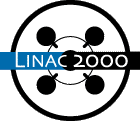
C. ADOLPHSEN, K.L.F. BANE, V. DOLGASHEV**, K. KO, Z. LI, R. MILLER (SLAC)
In the linac of the Next Linear Collider (NLC), trains of 95 bunches will traverse the linac on their way to the collision point. A major concern in the linac design is the beam emittance growth that results from the interactions of the bunches through the long-range transverse wakefields they generate. To suppress these wakefields, the linac accelerator structures are designed to damp and detune the dipole modes. In this scheme, the focus is on the modes in the first dipole pass-band since they are much stronger than those in the higher bands. However, at the level of wakefield suppression required (about two orders of magnitude), the contribution from the higher band modes may be significant. In this paper, we use a scattering matrix approach to compute their contribution in a simplified 2D structure. The results are compared with those from both an uncoupled cell calculation and a more accurate, though more computationally intensive, finite element calculation. The effect on the beam dynamics will also be discussed, as will experimental data.
*Work supported by the US Department of Energy contract DE-AC03-76SF00515.
**Visitor from Budker INP, Novosibirsk, Russia.
Comments or Questions to
linac2000@slac.stanford.edu